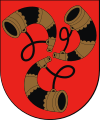Piaski
| Piaski | ||
|---|---|---|

|
|
|
| Basic data | ||
| State : | Poland | |
| Voivodeship : | Lublin | |
| Powiat : | Świdnicki | |
| Gmina : | Piaski | |
| Area : | 8.44 km² | |
| Geographic location : | 51 ° 8 ' N , 22 ° 51' E | |
| Residents : | 2553 (June 30, 2019) | |
| Postal code : | 21-050 | |
| Telephone code : | (+48) 81 | |
| License plate : | LSW | |
| Economy and Transport | ||
| Street : | E372 Lublin - Zamość | |
| E373 Piaski– Chełm | ||
| Next international airport : | Rzeszów-Jasionka | |
Piaski , formerly Piaski Luterskie , is a town with 2553 inhabitants in Poland . It has an area of 9 km² and belongs to the Powiat Świdnicki of the Lublin Voivodeship . Piaski is located 16 km southeast of Świdnik on the Giełczewka River and is the seat of the town-and-country municipality of the same name with 10,538 people (as of June 30, 2019).
History until 1939
The first written mention of the village of Piaski comes from the year 1401. In the 15th century the place received city rights . Pyassek alias Gyelczew was first mentioned as a city in 1470 . In the 16th and 17th centuries, the population was largely Protestant, so that during this time the city name Piaski Luterskie became naturalized. In the period that followed, the number of Jewish residents grew rapidly. At times it was over two thirds of the total population and a shtetl was created . In 1795 the city came to Austria during the Third Partition of Poland , which soon lost these areas again. In 1809 Piaski belonged to the Duchy of Warsaw and from 1815 to Congress Poland . In 1869 the place lost its town charter (which it only got back in 1993). With the establishment of the First Polish Republic , the place belonged to Poland.
Jewish Ghetto (Piaski Camp)
Of the 3974 inhabitants in 1921, 2,674 were Jews. After the German occupation in World War II , Piaski became part of the Generalgouvernement ; At that time, 4165 Jews lived in Piaski. A ghetto was set up in the Jewish shtetl in Piaski at the beginning of 1940 , to which Jews from the Lublin ghetto and from the German Reich (Stettin) were also deported. From March 1942, transports were carried out to the Belzec extermination camp , while 4,200 Jews from the German Reich and twice 1,000 from the Theresienstadt ghetto were deported here, and the number rose to 6,500. Under the command of Karl Streibel , 4,000 Jews were transferred to the Trawniki forced labor camp in October 1942 . From November the number rose again to 6000, the men were deported to Trawniki in March, the fate of the women and children when the ghetto was dissolved is not known.
In December 1952, the Aschaffenburg Regional Court acquitted Gendarme Z. of the charge that he was responsible for the mistreatment and killing of Jews in Piaski, since the testimony sworn before the Lublin District Court was too general and contradictory and the accused were not Had the opportunity to be present at the hearing of the witnesses.
Today's church
In addition to the city of Piaski, the urban and rural community includes 40 localities with a school administration office .
sons and daughters of the town
- Antoni Norbert Patek (1812–1877), watchmaker and founder of the Swiss luxury watch manufacturer Patek Philippe
Transmitter
Since 1990 there has been a 342 meter high transmission mast for VHF and TV near Piaski at 51 ° 8 ′ 2 ″ N , 22 ° 52 ′ 18 ″ E. This radio mast has been the fourth tallest structure in Poland since the Radio Warsaw radio mast in Konstantynów collapsed .
literature
- Piaski Luterskie , in: Guy Miron (Ed.): The Yad Vashem encyclopedia of the ghettos during the Holocaust . Jerusalem: Yad Vashem, 2009 ISBN 978-965-308-345-5 , pp. 584f.
Web links
- City and municipality website (Polish)
- Website about the evangelical parishes of Lublin and Piaski (multilingual)
- Website about Jewish life in Piaski (English)
- http://www.trawniki.hg.pl/traw/radiowtr.html
Individual evidence
- ^ Piaski , at ghetto-theresienstadt
- ↑ In the Encyclopedia of the Ghettos , under the entry Piaski , another ghetto in a village Piaski / yd: Piesk / ru: Peski, near Waukawysk , is listed with approx. 2000 murdered (p. 583f.)
- ^ LG Aschenburg, December 2, 1952 . In: Justice and Nazi crimes . Collection of German criminal judgments for Nazi homicidal crimes 1945–1966, Vol. X, edited by Adelheid L. Rüter-Ehlermann, HH Fuchs, CF Rüter . Amsterdam: University Press, 1973, No. 333, pp. 241-244. Abuse, individual and mass killings of Jews in the Piaski Ghetto ( Memento of the original dated December 8, 2016 in the Internet Archive ) Info: The archive link was inserted automatically and has not yet been checked. Please check the original and archive link according to the instructions and then remove this notice.
